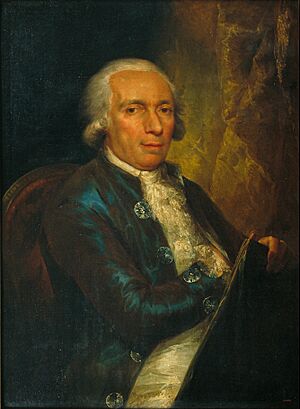Pasqual Pere Moles facts for kids

Pasqual Pere Moles i Coronas (born October 23, 1741, in Valencia; died October 26, 1797, in Barcelona) was a talented Spanish artist. He was especially known for being an engraver, which means he created pictures by carving designs into metal plates. He also became the very first Director of the Escola de la Llotja, an important art school, and held that job until he passed away.
Contents
Pasqual Pere Moles: Artist and Teacher
Early Life and Training
Pasqual Pere Moles grew up in a family where his father, Salvador, was a bookseller. From a young age, Pasqual showed a passion for art. He first studied with artists like José Vergara and José Camarón. Later, he continued his art education at the new Real Academia de Bellas Artes de San Carlos in Valencia.
After his studies in Valencia, he moved to Barcelona. There, he learned from another artist named Francesc Tramulles i Roig. Pasqual liked Barcelona so much that he decided to stay there.
Becoming a Royal Engraver
In 1762, Pasqual became an engraver for the Junta de Comercio, a special trade board in Barcelona. He helped create engravings for a big event called the Máscara Real (Royal Mask) in 1764. This event celebrated King Charles III of Spain and his wife, Maria Amalia of Saxony, arriving in Barcelona.
His excellent work led to him being recognized by the Real Academia de Bellas Artes de San Fernando. He even received a special pension from the Junta. This money allowed him to travel to Paris, France, from 1766 to 1774. In Paris, he improved his engraving skills by studying with famous artists like Nicolas-Gabriel Dupuis and Charles-Nicolas Cochin.
Founding a New Art School
Pasqual Pere Moles was one of the key people who started the "Escuela Gratuita de Diseño" (Free School of Design). This school is now known as the Escola de la Llotja. It was supported by the Junta de Comercio and opened its doors in 1775 at the Llotja de Mar building.
As the school's first Director, Pasqual believed in a new way of teaching art. He supported the academic approach of Anton Raphael Mengs. This meant focusing on proper techniques and theories, rather than just teaching art as a simple trade. He worked hard to organize the school and even helped create its museum. This museum became the very first art museum in Catalonia, a region in Spain. Today, its collection is part of the Reial Acadèmia Catalana de Belles Arts de Sant Jordi.
Later Works and Legacy
Even while leading the new art school, Pasqual continued his own work as an engraver. He became very skilled in chalcography, which is a type of engraving done on copper or brass plates. After 1779, he spent a lot of time creating illustrations for a historical book called Memorias históricas by Antonio de Capmany.
Pasqual Pere Moles left a lasting impact on art education in Spain. He helped shape how artists were trained and made sure that art was seen as an important academic subject.
See also
 In Spanish: Pasqual Pere Moles para niños
In Spanish: Pasqual Pere Moles para niños


